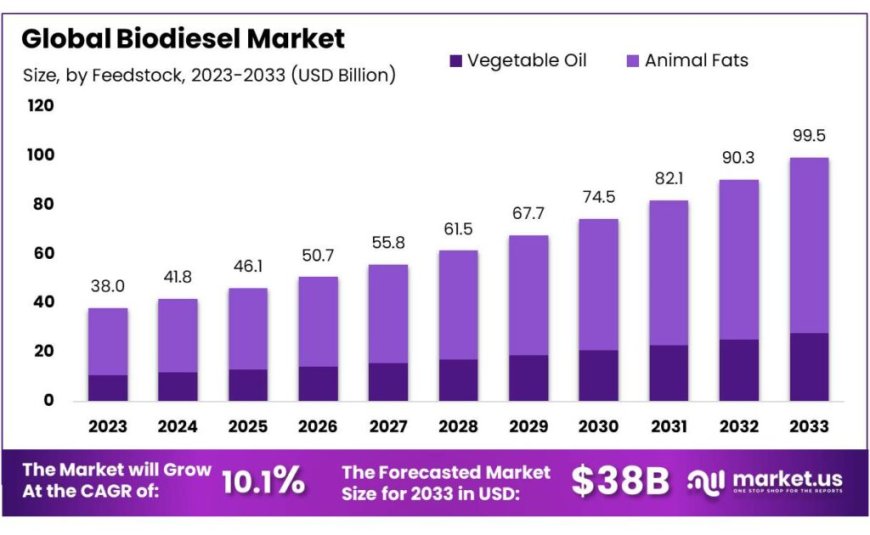Agricultural Biogas Solutions: Livestock Waste and Crop Biomass Revolutionize Energy Production
Biodiesel Market By Feedstock (Vegetable Oils and Animal Fats), By Application (Fuel, Marine, Automotive, Power Generation, Agriculture, and Other Applications), By Region and Companies - Industry Segment Outlook, Market Assessment, Competition Scenario, Trends and Forecast 2023-2033
Biogas Market Size accounted for USD 44.7 billion. This market is estimated to reach USD 71.3 billion in 2032 growing at a CAGR of 4.9% between 2023 and 2032.
The biogas market revolves around producing energy from organic materials like agricultural residues, food waste, and sewage sludge through a natural process called anaerobic digestion. This process involves microorganisms breaking down these materials in the absence of oxygen, producing biogas as a result. Biogas primarily consists of methane and carbon dioxide, with smaller amounts of other gases, making it a versatile renewable energy source.
Get a Sample Copy with Graphs & List of Figures @ https://market.us/report/biogas-market/request-sample/
Increasing environmental concerns and the need for sustainable energy solutions play a significant role in its growth. Governments around the world support biogas production through favorable policies and incentives, encouraging industries and communities to adopt this cleaner energy alternative. The economic benefits of biogas production, including waste reduction and potential revenue from selling energy or by-products like fertilizers, further contribute to its expanding market presence.
Market Key Segments
Based on Source
-
Municipal-
-
Landfill
-
Wastewater
-
Industrial-
-
Food Scrap
-
Wastewater
-
Agricultural-
-
Dairy
-
Poultry
-
Swine Farm
-
Agricultural Residue
Based on Application
-
Electricity Generation
-
Heat Generation
-
Cogeneration
-
Other Applications
The biogas market is diversified by source, with municipal waste holding the largest share at 41%, derived from household and municipal organic materials processed in anaerobic digesters. In terms of applications, electricity generation leads with a 30% market share, utilizing biogas for power generation through engines or turbines, while also supporting biofuel production and heat generation for industrial and residential uses, including cogeneration for efficient energy production and usage.
Market Key Players
-
Agrinz Technologies GmbH
-
Air Liquide
-
DMT International
-
Gasum Oy
-
Home Biogas Inc.
-
PlanET Biogas
-
Scandinavian Biogas Fuels International AB
-
Schmack Biogas Service
-
Total
-
Xebec Adsorption Inc.
-
Other Key Pl7ayers
Drivers:
Biogas as Renewable Energy Source: Produced from organic waste, biogas serves as a sustainable energy solution, driven by increasing environmental awareness and the need for cleaner fuel alternatives. Government incentives worldwide support biogas production, mitigating high capital costs and promoting market entry, especially in urbanized areas with abundant waste streams.
Restraints:
Costly Implementation for Small-Scale Projects: High capital requirements hinder investment in biogas plants, particularly in developing countries. Dependence on organic feedstocks like animal waste and energy crops limits scalability and increases production challenges in regions with scarce resources.
Opportunity:
Technological Advancements in Biogas Production: Innovations in anaerobic digestion technologies enhance biogas quality and quantity, facilitating global market expansion. Urbanization and industrial growth increase organic waste streams, boosting demand for biogas as a renewable energy source.
Challenge:
Infrastructure Limitations: Biogas production requires specialized equipment and infrastructure, posing challenges in rural or remote areas lacking access to digesters and pipelines. Maintaining optimal operational conditions remains critical, with equipment reliability issues impacting production efficiency and cost-effectiveness.

What's Your Reaction?
 Like
0
Like
0
 Dislike
0
Dislike
0
 Love
0
Love
0
 Funny
0
Funny
0
 Angry
0
Angry
0
 Sad
0
Sad
0
 Wow
0
Wow
0























































